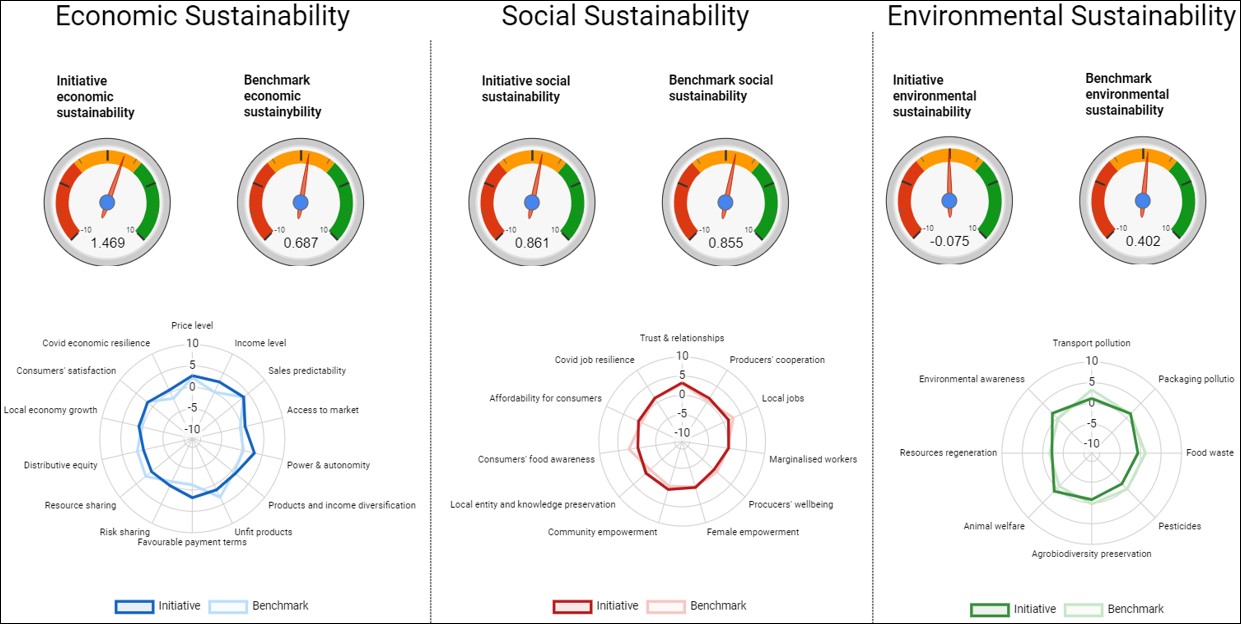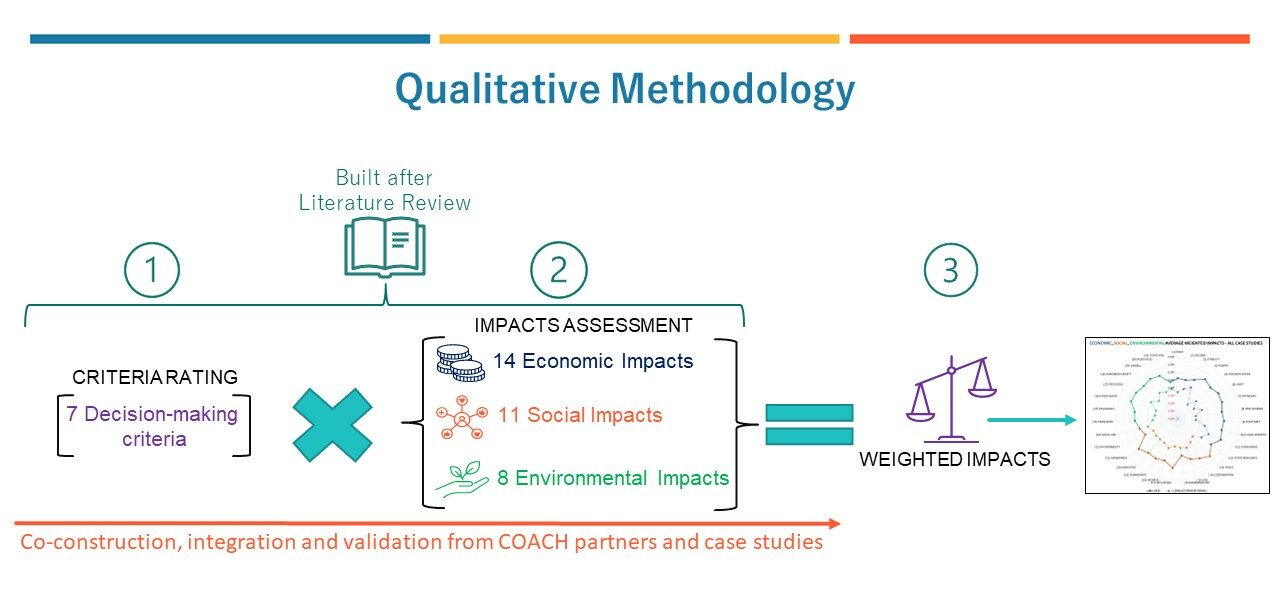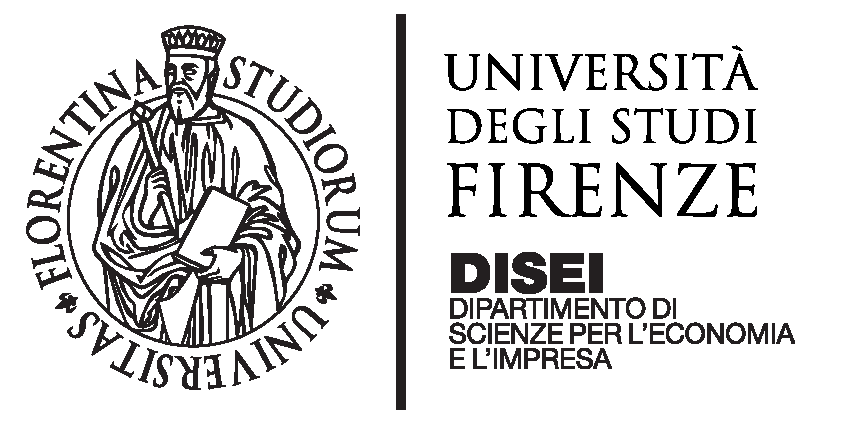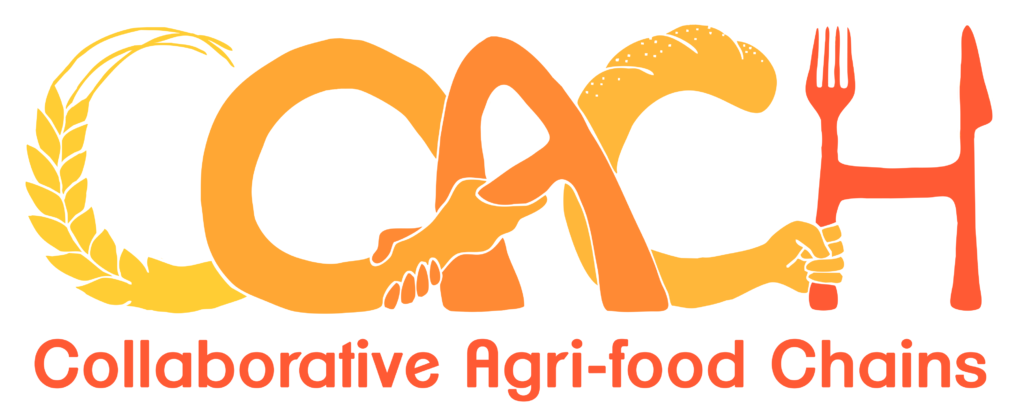Qualitative Sustainability Self-Assessment App:
how to use it?
Qualitative methodologies are employed to collect and analyse non-numerical data regarding opinions, deep motivations, perceptions and values behind people’s behaviours.
We present here a Sustainability Self-Assessment App for the qualitative assessment of C&Bs, designed by the University of Florence (I) within the COACH project and based on the costs and benefits methodology developed in the same framework.
The sustainability self-assessment App is a freely available, simple and intuitive tool, made for assessing the impacts that a given SFSC initiative generates on the actors involved, on the community, and the territory where it takes place, under the economic, social and environmental dimensions.

The tool is built in a way to compare multiple distribution channels, which can be short VS long channels, but also different short channels between them, as to enable respondents to compare the different marketing options they are using or that are available to them.
The usefulness and the aim of the tool is, at first place, to stimulate awareness and reflection of respondents on C&Bs aspects of engaging in SFSCs, as to enable informed decisions between different marketing options, taking into account all the three dimensions of sustainability (economic, social and environmental).
The App has been designed for collective participatory assessment by groups of producers involved in collaborative SFSCs initiatives (e.g., farmers’ market, solidarity purchasing groups, community supported agriculture, producers’ cooperatives, food hubs). However, the App can be used also by single producers wishing to assess their performance in SFSCs.
In case of collective SFSC initiatives, the coordinator of the initiative (i.e., the responsible of a farmers’ market or a farmers’ shop) registers the initiative on the tool (filling in the Questionnaire for Coordinators), and then invites all the members of the initiative to fill in the individual self- assessment questionnaire (see Questionnaire for Producers belonging to a registered initiative).
Once the questionnaires for producers have been filled by participants, the coordinator will have access to the whole set of results, being able to use them to activate discussion and stimulate collective reflection between participants.
This process can be very useful to foster collective participatory reflection, leading to increased awareness, highlighting strengths and weaknesses of the initiative, identifying opportunities to be caught, threats to be considered, and spaces for improvement.
Questionnaire for Coordinators
Register your SFSC initiative!In the case of collective initiatives, the coordinator has to follow these steps:
- First, register the initiative by filling in the Questionnaire for Coordinators. This is a very short questionnaire with some basic descriptive questions on the initiative that is being registered, and it has the purpose of registering the initiative on the tool in order then to be able to associate each producer’s answer to the initiative which he/she belongs to.
- After registering the initiative, the coordinator will receive two links by email.
- The first link connects to the producers’ questionnaire. The coordinator should forward this link to each producer of the SFSC initiative willing to participate to the exercise by filling in the self-assessment questionnaire.
- The second is a link to the coordinator’s dashboard where he/she will have access to the results from all the questionnaires filled by the producers of the initiative, as well as some average results, displayed using some graphical representation.
- Once the producers have filled in the producers’ self-assessment questionnaire, the coordinator will be able to see and download the individual and averaged collective results from his/her own dashboard (see figure), using the second link received by mail.

Questionnaire for Producers belonging to a registered initiative
The Questionnaire for Producers is the survey that every producer willing to take part to the self- assessment exercise has to fill in.
For collective initiatives, each producer will receive the link to the questionnaire from the coordinator of the initiative he/she is member of, after the coordinator has completed the registration process for the initiative (the first link the coordinator receives by email after registering the initiative on the tool). If you are a member of a collective initiative willing to do a participatory assessment, do not use the link for single producers, as your answer needs to be associated with the initiative you are part of! Your coordinator will send you the right link to access you self-assessment questionnaire.
The Questionnaire for Producers is composed of different sections:
- Section I requires some very general descriptive information on the initiative the producer is part of.
- Section II requires some descriptive information on the producer’s company, the products sold, and the distribution channels used
- Section III contains a questionnaire on decision-making criteria: producers are asked to evaluate the importance of a set of criteria when making productive and marketing decisions in their company.
- Section IV contains the sustainability impacts assessment: producers are asked to evaluate the impact of the SFSC initiative they belong to, and of another “Benchmark” distribution channel (short or long, at his own choice), on a set of economic, social and environmental aspects.
After completing and successfully submitting the questionnaire, producers will receive by email a link to their own dashboard, where they will be able to see and download their own results. For privacy reasons, unlike coordinators, producers will be able to see only their own results, but not other producers’ results nor the averaged collective results.
Single producers engaging in SFSCs which do not belong to any collective initiative or network, can still use the Qualitative Sustainability Self-Assessment App, to evaluate their performance and gain awareness of the impacts of their different marketing options. They can directly access to the Questionnaire for Producers, which will be the only questionnaire they need to fill in.
After completing it, they will receive by email the link to their own dashboard, where they will be able to see and download the results from their self-assessment.
The App is built following a qualitative methodology, which performs a sustainability impacts assessment based on the perceptions of respondents, who are asked to self-assess the impacts of the SFSC initiative they are involved in compared to the impacts of another marketing option available to them, named Benchmark (which normally is a long distribution channel, or also a short traditional one).
The questionnaire for producers, which is the core part of the tool, is composed of two main parts.

In the first part, respondents are asked to rate the importance of a list seven relevant criteria that producers usually take into consideration when making decisions about their production activity and their marketing channels.
In the second part, respondents are asked to state what is the impact according to them of the SFSC initiative they are engaged in and the of another marketing channel available to them (short or long, called “benchmark distribution channel”) on a list of 33 economic, social and environmental aspects.
After the questionnaire has been fully completed, the tool converts the answers to the first part on decision-making criteria into numerical “weights”. Then, it matches the 33 economic, social and environmental impacts to the seven decision-making criteria, and the weights generated from the criteria are used to weigh the answers from the impact assessment. This procedure allows to generate some “weighted impacts”, which capture not only the perceived impact of the two distribution channels (SFSC and Benchmark) on the economic, social and environmental aspects considered, but also the relative importance of each aspect in the decision-making process of the actors interviewed.
The tool, starting from weighted impacts, generates a short report with performance dashboards and other graphical representations, which respondents can access using the link they receive by email once filled the questionnaire.
Only coordinators of an initiative will receive all the set of results from all their connected producers, while single producers will be able to access only to their private individual results.


